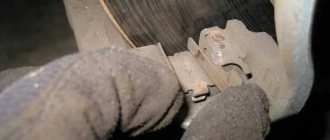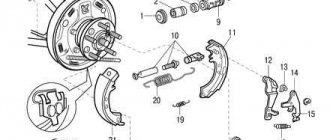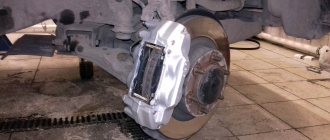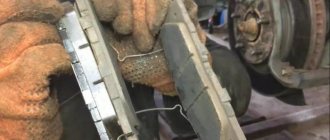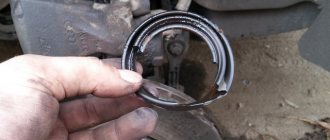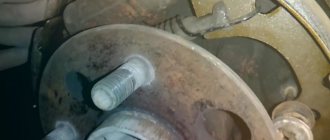The brake system is responsible for the safety of any car, for this reason it needs to be given careful attention and timely technical inspection and repairs. Replacing Toyota Corolla brake pads is required during scheduled maintenance.
There are several ways to replace pads:
- self-replacement;
- replacement at a car service center.
When replacing pads at a car service center, everything is clear. The car is sent for service, and at the appointed time the owner comes with the money to pick up his serviced car.
Of course, in the service, experienced craftsmen who know their business will quickly and efficiently replace the pads, but this will cost a lot of money. Wanting to save money when servicing their car, many owners prefer to change the brake pads themselves.
To replace it yourself, you only need desire and a standard set of tools, namely:
- wheel wrench;
- jack;
- mount;
- metal brush;
- wrench with a set of heads.
The process of replacing front pads on a Toyota Corolla 2008
The pads located on the front axle of the car wear out much faster than those on the rear axle. If you hear an unpleasant creaking sound in the wheel area during freezing, this is the first sign of wear on the brake pads.
To replace the front pads, you need to jack up your car and remove the wheel. After removing the wheel, you can see the caliper, brake disc and the pads themselves.
Using a wrench and a 14mm socket, the lower and upper caliper mounting bolts are unscrewed, while holding the caliper.
Unscrew the bolts while holding the caliper
Remove the caliper
After unscrewing, the caliper is carefully removed to the outside of the car. In this case, it is necessary to ensure that there is no strong tension in the brake hose going to the brake cylinder fitting.
Pry up the block with a screwdriver
Check the condition of the brake disc
Install the new block in place
Next, the pads are removed from both sides. If they are stuck to the brake disc, you can pry them out with a screwdriver. The main thing is not to damage the brake disc.
Then the condition of the brake disc is inspected, and new brake pads are installed in place of the old ones. It is necessary to use only original pads with number 0446502390.
After installation, assembly is carried out in the reverse order.
The process of replacing rear pads on a Toyota Corolla
Remove the wheel
Loosen the top guide
Unscrew the bottom guide
To replace the rear pads, you need to jack up the car and remove the wheel. Next, using a 12mm wrench and a socket, the lower guide on the caliper is unscrewed, the clamping bracket is pulled up and the bad pads are removed.
Attention: only the bottom guide needs to be unscrewed. It is impossible to remove the brake pads with the top guide unscrewed.
Next, the pads are cleaned of dirt using a metal brush and the anti-squeak plates are removed. Toyota manufacturers recommend installing new plates when replacing pads, but you can leave the old ones. The final process is assembly, which occurs in reverse order.
It must be remembered that when you press the piston of the brake cylinder, the level of brake fluid in the expansion tank may increase. For this reason, before installing new pads, it is necessary to carefully clean the pad seats from dirt and rust using a metal brush.
Replacing Toyota Corolla brake pads is not a complicated procedure.
Solving this problem yourself will not only save money, but also increase your experience in car maintenance.
Design features of the brake system
The Corolla has disc brakes on all four wheels, so replacing Toyota Corolla brake pads on the front and rear axles is not much different and not particularly difficult. However, some features should still be taken into account when replacing these parts.
In order to change the pads on the Corolla in accordance with the manufacturer’s recommendations, you should not select this part yourself. Brake pads offered by manufacturers vary in shape and thickness, attachment points, and the presence or absence of electronic wear sensors. The pads differ depending on the engine size, as well as the mounting method. Different bases are used in production. For example, they could be:
- organic;
- ceramic;
- metallic (semi-metallic).
Purchase brake pads using the part number, and when choosing a manufacturer, give preference to well-known certified manufacturers such as TRW, Kashiyama, Nisshinbo.
Replacing brake pads Toyota Corolla detailed instructions, many photos
Replacing Toyota Corolla brake pads is usually required after 30-50 thousand mileage. Such a large range is associated with a large number of factors, ranging from driving style to the condition of the brake disc.
The front brake design of the Toyota Corolla is a disc mechanism with automatic adjustment of the gap between the pads and the disc with a movable caliper. A single-piston working brake cylinder is mounted on a movable bracket. The shoe guide is attached with two bolts to the steering knuckle. The movable bracket is bolted to guide pins installed in the shoe guide holes.
The guide pins are lubricated with grease and protected by rubber covers. A piston with an o-ring is installed in the cavity of the cylinder of the movable bracket. Due to the elasticity of this ring, an optimal gap is maintained between the pads and the ventilated disc, the surface of which is protected by the brake shield.
Naturally, replacement of Toyota Corolla pads must be carried out on both wheels at once; when replacing brake discs, the pads also require replacement. The process of replacing pads on a Toyota Corolla is not much different from the same procedure on other similar cars, although it has its own characteristics.
We hang up the front of the car and remove the wheel. By inserting a mounting spatula or a screwdriver with a wide blade between the pad guide and the caliper and resting it on the guide, we move the caliper, recessing the piston into the cylinder. This will help us remove the old pads more easily.
Using a spanner or socket, unscrew the lower bolt securing the caliper to the guide pin while holding the nut with another wrench. Raise the caliper by turning it around the axis of the upper guide pin. We remove the pads from their guide.
Remove the two spring clamps of the pads. Using a metal brush, we clean the pad seats in their guide from dirt and corrosion. Before installing new pads, we check the condition of the protective covers of the guide pins. We replace the torn or lost elasticity cover.
To do this, remove the finger from the hole in the pad guide and remove the cover.
Before installing the pin, put a little grease (special high-temperature grease for brake pins) into the hole in the pad guide and apply a thin layer of lubricant to the surface of the pin. If your finger is covered with rust, be sure to clean it.
Another important point is the mandatory lubrication of the plate (which is placed on the block and covered with an overlay) with a special heat-resistant lubricant. Original pads come with lubricant included. Next in the photo you can see this plate, which is designed to prevent the pads from squeaking when braking.
Operating principle
To understand why they wear out, you need to know how the pads work. Brakes are cylinders that, when the pedal of the same name is pressed, press the pad against the wheel. The greater the pressure in the cylinder, the stronger the device is pressed.
However, during frequent sharp braking, the rubber wears off and the springs wear out. Therefore, old pads must be removed.
Replacing the rear brake pads of a Toyota Corolla can be done with your own hands without visiting a service center. To do this procedure correctly, just read and follow the following instructions.
Replacing Rear Brake Pads for Toyota Corolla 150
Toyota Corolla E140 changing brake pads
rear wheels and discs.
We have a Toyota Corolla E140 for scheduled maintenance, where we need to change the brake pads
rear wheels and discs. We will show you a detailed photo and annotation on how to do this at home.
We lift the car, if you do this with a jack, remember to place bricks or wheel chocks under the other wheels. Using a 14mm socket and a 17mm wrench, unscrew the guides:
We remove the caliper and take out the old pads. Unscrew the two caliper bracket bolts (to change discs):
We remove the bracket and dismantle the old brake disc; often they stick tightly to the seating surface; in such circumstances, because we replace them anyway, of course knock them off with a few sharp blows of a hammer on the back surface.
We clean the seating surface using a brush with iron bristles; if possible, we treat it with copper or graphite grease, so that during the upcoming replacement we will not have problems with sticking.
We install a new brake disc, do it with gloves:
Replacing rear brake pads for Toyota Corolla
Not a great overview on replacing rear brake pads
by car
Toyota Corolla
.
High temperature lubricant for brake service
I spent a long time searching and reading about lubricants for brake system elements. Many people unknowingly lubricate the guides with the grease that comes with the brake pads, but it is intended for completely different purposes, and is not intended for the temperatures at which the caliper guides operate. And in the end I purchased for existential testing: Vmpauto 1502 Lubricant for calipers, universal “Ms 1600” costing 312 rubles 82 kopecks. The tube is 50 grams, although you could take 100 grams at once, the difference in price is not significant.
As he writes
We buy consumables for rear brakes
On the rear guides, as well as on the front, one guide has an elastic band. The only difference is that on the front calipers the guide with the rubber is at the top, and on the rear calipers at the bottom. I didn’t have these rubber bands on the guides; the old owner of the car took them somewhere or the service station removed them when servicing the brake system. The rubber bands are not sold separately, only in a set with guides. I bought a repair kit for the front, and the guides for the rear are in good condition.
Caliper guide bushing 47769-05020
But the rubber bands for the rear brake caliper guides are sold separately on Toyota Avensis, which I purchased: 47769-05020 Caliper guide. Two elastic bands for 157 rubles. 52 kopecks They are a millimeter longer, we cut them with a utility knife and they sit like they belong.
How to change the front ones
- The front brake pads are very easy to change. The second time, the procedure will take you no more than 10 minutes per wheel. We install chocks under the wheels and put the car on the handbrake. Turn the wheel on which you will change the pads outward, this will make it easier to work with the caliper.
Clamps will help with adjustment
They do not allow the overlays to be placed incorrectly.
New consumables in place
Release the brake cylinder
If you have any questions, watch the video.
How to replace: video guide
As you can see, disc brakes are much easier to change than drum brakes. Their braking efficiency is relatively the same, but drum brakes are prone to overheating (but their service life is 2-3 times longer).
How to change the front ones
- The front brake pads are very easy to change. The second time, the procedure will take you no more than 10 minutes per wheel. We install chocks under the wheels and put the car on the handbrake. Turn the wheel on which you will change the pads outward, this will make it easier to work with the caliper.
Clamps will help with adjustment
They do not allow the overlays to be placed incorrectly.
New consumables in place
Release the brake cylinder
If you have any questions, watch the video.
How to replace: video guide
As you can see, disc brakes are much easier to change than drum brakes. Their braking efficiency is relatively the same, but drum brakes are prone to overheating (but their service life is 2-3 times longer).
Which ones to choose?
Today there are many different manufacturers. The highest quality pads are produced by Germany, France, Spain and Japan. In addition to the manufacturer, it is important to choose the right size pads for your wheel caliper. Like any spare part, they are divided into: original and non-original. It's your choice here. The original lasts significantly longer than the non-original. The price of such pads is usually twice as high. In general, as always, it’s up to you to decide whether to choose the quality or cost of the product.
